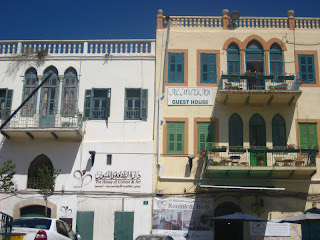On Tuesday, the Arabic students went to Nazareth for the day. We saw quite a bit more than the Church of the Annunciation, which is the only thing I really got to see the last two times I went to the city. For photos of the Church of the Annunciation, refer back to this post.
Greek Orthodox Church of the Annunciation:
(from Wikipedia)
Greek Orthodox Church of the Annunciation:
The Greek Orthodox Church of the Annunciation, also known as the Church of St. Gabriel or St. Gabriel's Greek Orthodox Church, is an Eastern Orthodox church inNazareth, Israel. Likely first established in Byzantine-era Palestine, it was rebuilt during the time of the Crusades, and again in the 18th century under the rule of Daher el-Omar, the Arab governor of the Galilee.[1]
Known colloquially among the Arab citizens of Nazareth whom it serves as Keniset il-rum,[i] the church is located over an underground spring, which according to Eastern Orthodox belief is where the Virgin Mary was drawing water at the time of theAnnunciation.[2][3] Water from the spring still runs inside the apse of the church and also fed the adjacent site of Mary's Well, located 150 yards (140 m) away.[1][4]
(from Wikipedia)
(this is right over the spring)
Many of the Ottoman-era mansions have been turned into restaurants and/or nice hostels.
(L: the first sign i was able to read in Arabic on my own ^_^)
(Ottoman-era door big enough for camels, but the mini door in the middle was intentionally small so that visitors would be "weakened" upon entry, giving the host an upper hand)
(face!)
(some European influence in one of the Ottoman-era mansions-turned-into-a-hostel)
While the Greek Orthodox believe that Gabriel came to Mary at the well, Catholics believe that Gabriel came to Mary at her home to tell her that she will give birth to Jesus.
There are four layers of churches at this site: 1) Byzantine: ~4th century, destroyed in 7th after the Muslim conquest of Palestine; 2) Crusades: ~12th century, destroyed in 1260 by Mamluk army; 3) Period of Dhaher al-Omar: ~18th century, demolished in 1954 for the... 4) Most recent version: 1969, designed by Italian architect Giovanni Muzio.
(reminder: more photos in this entry from a couple weeks ago)
("Doctor ____ would you trust?")
(yes, it is massive)
(apse to the right)
(site of "Mary's home")
(Byzantine-era mosaic floor)
(you may be able to make out Byzantine flower murals in the center of the photo, with remnants of the church from the period of Dhaher al-Omar around it)
(this is the second floor, which is a Catholic church; the previous photos were from the first floor, which features the layers of churches over time)
(tilt your head right; this is a close-up shot of Japan's Mary and Jesus mosaic... it is notable because of all the inlaid pearls on Mary's sleeve... there's another mosaic that we didn't have access to which has diamonds on the sail of a boat that features Cuban immigrants to the United States)
Church of St. Joseph: (<much better photos on the hyperlinked site)
I didn't post any photos from this little side church last time, so here are some. It is quaint and often overlooked... our tour actually skipped it altogether, but a friend and I stepped inside for a bit.
First, this neat sculpture was in front of the Franciscan Convent, which is between the Church of the Annunciation and Church of St. Joseph:
(i hope you can read the text; let me know if you cannot)
(neat stained glass in the organ)
The Synagogue Church is a 12 C AD Church , built by the Crusaders. According to tradition, the church was built above the original location of the Roman period Synagogue where Jesus first learned, prayed and later preached as a young man. (from biblewalks.com, emphasis added)
(it was a very simple space; there are better photos in the hyperlink above)
The White Mosque (Arabic: المسجد الأبيض) is the oldest mosque in Nazareth, Israel[1]and is located in Harat Alghama or the "Mosque Quarter" in the center of Nazareth's Old Market.[2] Its exquisite pencil-shaped minaret,[2] cream-coloured walls, green trim and green dome are just one example of the Ottoman architecture common throughout the city.
(from Wikipedia)
(L: the mihrab)
(area for ablution)
and finally! al-Sadaqa baklava in action: (<this hyperlink has close-up photos of each kind of baklava, which is delightful)
(baklava frying...)
(the hairy ones (here filled with goat cheese)!)
(my new friend Amer S. Ha rolling out 20 layers of filo dough for new baklava pieces with pistachio filling)
Video of him rolling it out (it started about a foot in diameter then grew, grew, grew):
Video of him filling it in:
(scores of choices!)
(bought a tray-full to take home for my roommates... got a few pieces of Qatayef for Ramadan as well)
P.S. I'd like to post some photos of my beloved roommates, but the ones I took don't have Marwa in her hijab so I can't post them. Soon, though! On a related note, as I was uploading photos for this post slash studying for my midterm, Marwa came in with plates of her homemade cheesecake for me and Maria.
Aww! Today, we had an Italian lunch a la Giusi and an Arabic dinner (broke fast) a la Marwa. I think I'll contribute by making a Japanese curry that I brought with me from the States (no Korean ingredients here!)...




















































No comments:
Post a Comment